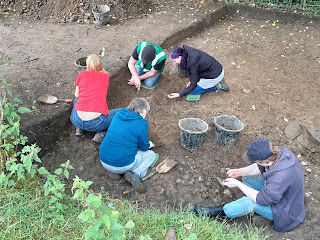On the 8th of November 2023, members of Lancashire Wildlife Trust’s ‘Sphagnum Squad’, Andy Osborne and Tony Rogers, teamed up with Dom Hartley (Forest of Bowland National Landscape Peatland Officer) on a pioneering plant translocation project, the first of its kind for the Lancashire Peat Partnership.
Over many years Lancashire Wildlife Trust staff and
volunteers have been hard at work undertaking restoration work on a number of
lowland peatlands across Chat Moss in Greater Manchester. These were in varying
states of poor condition due to years of mismanagement by previous owners. 10
years on from works beginning at one of these sites, which is remaining unnamed
to protect the sensitive vegetation at the site, it has been transformed; from
bare and actively eroding, to holding water and covered with common cottongrass
and sphagnum moss.
Given the much-improved habitat conditions the Sphagnum
Squad have turned their attention to reintroducing even more specialised bog
vegetation, starting with Bog asphodel.
Bog asphodel favours wet, acidic and low-nutrient
conditions, meaning that it can really flourish across blanket bogs in good
condition. Across such sites in the Forest of Bowland, Bog asphodel provides a
stark contrast to the usual moorland colour palette when it flowers between
June and September drawing both the eye and the pollinators.
The translocation of Bog asphodel is not something that volunteers at LWT or the Forest of Bowland National Landscape had been involved with before and it was therefore important to involve another key member of the Lancashire Peat Partnership – the Natural England area team. Their expertise was really helpful in making sure that the harvest at the donor site in Bowland was done in a bio-secure and sustainable fashion, meaning that the harvest of the donor plants has not negatively impacted the site in any way.
Following the securing of permissions from Natural England
and the landowner, United Utilities, Andy, Tony and Dom ventured off into the
middle of the Bowland Fells on a surprisingly dry and bright November morning. After
30 minutes of driving, they set off on foot to the donor site with plastic
containers and small spades. The donor site is a particularly wet and acidic
bit of bog, approximately 1.8ha in size, where Bog asphodel thrives (with up to
30 plants per square metre in places).
Bog asphodel at the donor site in the Forest of Bowland. Outside the flowering season, Bog asphodel still stands out on the moor with its yellow-orange leaves. Photo Dom Hartley
Nutrient levels and pH readings were taken prior to
harvesting so that the plants can be reintroduced to areas on the donor site with
similar readings; this will hopefully increase the chances of the donor plants establishing
in their new location and succeeding in the future. Plants were harvested from
across the donor site to minimise any impacts on the habitat.
Shallow incisions were made with the spades, 10-15cm deep,
around the target plants so that the rhizome of the Bog asphodel could also be
retrieved intact.
Tony displays a spade's-worth of Bog asphodel, with rhizome intact. Photo Andy Osborne.
This process was repeated across the donor site, with donor plants secured in plastic containers which would support waterlogged conditions for their safe transportation from Bowland down to Chat Moss.
Expert packing - the containers and Bog Asphodel secured for transport. Photo Andy Osborne.
Within three hours of harvest, the Sphagnum Squad were down at the donor site to get the plants into the ground – hopefully, this quick turnaround will benefit the plants and boost the success rates of the translocation.
Bog asphodel ready for planting at Chat Moss. Photo Andy Osborne
Bog asphodel re-planted, Tony records the location and conditions so that ongoing monitoring can be undertaken. Photo Andy Osborne
Nutrient levels and pH are tested at Chat Moss. Photo Tony Rogers.
The Bog
asphodel has been re-planted across Chat Moss, under a variety of conditions.
The plants and the surrounding conditions will be carefully monitored; whilst
we're hopeful that the translocation will have a 100 per cent success rate, if
some plants fail it is important for us to be able to try to understand why.
Pete Wilson,
Catchment Partnership Officer for United Utilities, landowner at the donor site
commented; "It's brilliant
to see the constituent parts of the Lancashire Peat Partnership working
together in this way. I'm happy to have facilitated the translocation of Bog
asphodel from one of our Bowland sites to Chat Moss. This is a real win for all
involved as we have an abundance of Bog asphodel across the Bowland estate and
the relatively small number of plants we've been able to donate to the ongoing
restoration efforts at Chat Moss will hopefully further the outstanding habitat
recovery we've seen there over the last decade".














































.jpg)
.jpg)
.jpg)
.jpg)
.jpg)
.jpg)
.jpg)
.jpg)